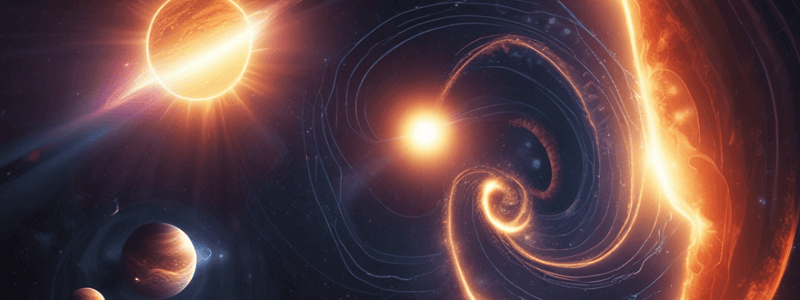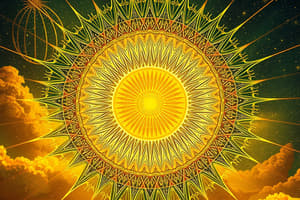Podcast
Questions and Answers
What keeps the sun stable as a main-sequence star?
What keeps the sun stable as a main-sequence star?
- Fusion energy pushing outward (correct)
- Gravity pulling inward (correct)
- Magnetic fields inside the sun
- Rotational force from the sun's spin
What will the sun's energy increase be in approximately one billion years?
What will the sun's energy increase be in approximately one billion years?
- 10% more than today (correct)
- 5% more than today
- 25% more than today
- 40% more than today
What happens to the sun after it runs out of fuel in six billion years?
What happens to the sun after it runs out of fuel in six billion years?
- It remains stable and continues fusion
- It expands into a red giant (correct)
- It ignites a series of supernovae
- It collapses into a neutron star
What is produced when helium nuclei in the sun are fused?
What is produced when helium nuclei in the sun are fused?
What occurs when the sun's core becomes unstable?
What occurs when the sun's core becomes unstable?
What will eventually happen to the outer layers of the sun?
What will eventually happen to the outer layers of the sun?
What remains after the sun has shed its outer layers?
What remains after the sun has shed its outer layers?
How does the sun end its life cycle?
How does the sun end its life cycle?
What will happen to the Earth as the sun gets 10% brighter in one billion years?
What will happen to the Earth as the sun gets 10% brighter in one billion years?
Which two planets will the sun likely engulf when it becomes a red giant?
Which two planets will the sun likely engulf when it becomes a red giant?
What marked the birth of the sun as a star?
What marked the birth of the sun as a star?
Approximately how long ago did the sun begin its life cycle?
Approximately how long ago did the sun begin its life cycle?
What is the primary material that makes up the sun?
What is the primary material that makes up the sun?
What happens to the material that does not settle into the center of the solar disc?
What happens to the material that does not settle into the center of the solar disc?
What is a characteristic of the sun during the main-sequence star phase?
What is a characteristic of the sun during the main-sequence star phase?
How many Earths could fit inside the sun?
How many Earths could fit inside the sun?
What initiated the formation of the sun from the nebula?
What initiated the formation of the sun from the nebula?
What was the ancient belief about the sun?
What was the ancient belief about the sun?
What was the process called that allowed the sun to increase temperature until nuclear fusion occurred?
What was the process called that allowed the sun to increase temperature until nuclear fusion occurred?
How long did it take for the ball of material in the nebula to begin nuclear fusion?
How long did it take for the ball of material in the nebula to begin nuclear fusion?
Flashcards are hidden until you start studying
Study Notes
Birth and Importance of the Sun
- The sun originated in a nebula approximately 4.6 billion years ago.
- It is the only star that significantly impacts life on Earth, despite not being visible at night.
- Ancient civilizations worshipped the sun, believing it to be a divine creation.
- Current understanding identifies the sun as a massive sphere of hydrogen undergoing nuclear fusion.
Size and Composition
- Over one million Earths can fit inside the sun.
- The birth of a star involves similar life cycles to humans: birth, life, and death.
- The sun formed in a giant interstellar cloud of dust and gas, which collapsed and began to spin.
Formation Process
- As the nebula collapsed, it formed a flat disc with most material concentrated at the center.
- For 100,000 years, the core was compressed, raising temperatures enough for nuclear fusion to begin, resulting in the birth of the sun.
- Remaining material in the disc developed into planets, moons, and other solar system bodies.
Main-Sequence Star Stage
- Upon initiating nuclear fusion, the sun became a stable main-sequence star, maintaining gravitational and fusion forces in balance.
- The sun continuously burns hydrogen fuel in its core, gradually increasing in energy output.
- In approximately one billion years, the sun's energy will increase by 10%, potentially causing a severe greenhouse effect and evaporation of Earth's water.
- In 3.5 billion years, the sun is predicted to become 40% brighter, leading to the evaporation of oceans, glaciers, and snow.
Future Transformations
- In about six billion years, the sun will exhaust its hydrogen fuel, leading to core collapse and increased instability.
- The core temperature will rise, causing the sun to expand significantly and enter the red giant phase.
- During this phase, helium in the core will fuse into carbon, increasing core pressure.
Final Stages
- Eventually, the sun will shrink to a carbon sphere, referred to as a white dwarf, after exhausting helium.
- The outer layers of the sun will be expelled, leaving behind a planetary nebula.
- The white dwarf will gradually cool, reaching a temperature just above absolute zero over time, marking the end of its life cycle.
Studying That Suits You
Use AI to generate personalized quizzes and flashcards to suit your learning preferences.




